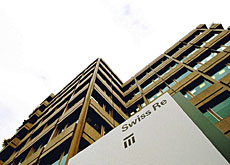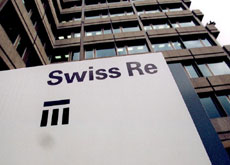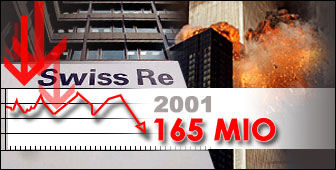Swiss Re storms into the black

Swiss Re, the world’s second-largest reinsurer, has seen its first-half net profit jump to SFr691 million ($488 million) - a six-fold increase on the first six months of 2002.
Total premiums generated during the first half of this year also rose, climbing four per cent to SFr14.4 billion.
The company produced positive results across all business units, with non-life divisions heading the field.
Company spokeswoman Samantha Whiteley told swissinfo that the hike in profits was due to a combination of factors.
“Most important are the hard market conditions we’re seeing in the reinsurance business. It means that at the moment capital is very scarce amongst insurance companies, and as a result they need to purchase reinsurance,” said Whiteley.
“This is a market phenomenon, but Swiss Re is taking advantage of it by actively and carefully re-underwriting its book of business, looking at every risk and ensuring that everything we underwrite is profitable and sustainable,” she added.
Top performers included Swiss Re’s property and casualty group, with operating income clocking in at SFr822 million, compared with last year’s SFr104 million.
“[This] business group is harvesting the benefits of the hard market and has increased premium income by 18 per cent to SFr7.9 billion,” Swiss Re said in a statement.
Turnaround
Positive growth was experienced in continental Europe, but premium growth in the so-called primary markets – such as the United States and Britain – was negative.
The reinsurance giant, however, stressed that it did not expect the growth rate experienced in property and casualty during the first half to continue into the second half of 2003.
Swiss Re’s financial services division also experienced a significant turnaround, posting a profit of SFr273 million. During the comparable period in 2002, the unit made a loss of SFr379 million.
There was good news too for shareholders – shareholders’ equity grew by SFr1.2 billion to SFr17.9 billion.
One blip in the results was the performance of the life and health group. Profits went down from SFr895 million in 2002 to SFr472 million this year.
This was due to the health results decreasing by 98 per cent because of the absence of one-off gains on recaptures present during 2002.
However, operating revenues for this business unit still increased by 8.1 per cent.
Weak dollar
Overall, the company said its results were affected by a weak dollar, which depreciated against the Swiss franc by 18 per cent during the first six months of 2003.
However, the company said it was content with its performance and was optimistic about the future.
The result comes a day after the market leader, Munich Re, reported its fifth straight quarterly loss.
“We are pleased… Swiss Re expects the hard market to continue and, with our focus firmly on profitable technical underwriting, our results should see ongoing improvement,” John Coomber, the company’s chief executive officer said in a statement.
Swiss Re predicted that the hard market conditions were here to stay.
The upsurge in the company’s fortunes follows a dismal performance last year, when it posted an annual loss for 2002 of SFr91 million. The company blamed the negative fallout from September 11 for its low-key results.
As a consequence, Swiss Re announced in March that it would slash its shareholder dividend for 2002 to SFr1 from SFr2.50.
swissinfo, Faryal Mirza
First-half profit for 2003 at Swiss Re are up six-fold to SFr691 million.
The company reported positive results across all business units.
Total premiums generated went up to SFr14.4 billion, a four per cent increase on the previous year.
Reinsurers insure insurance companies.
The “hard market” refers to the current economic reality for reinsurance companies, when profits begin to slide into real losses. Underwriters then put premiums up to cover past losses.
The opposite is the “soft market”, when companies find their profits rising. In order to increase their market share, underwriters lower premiums. Some analysts believe that the fall from “soft” to “hard” took place a few months before September 11.

In compliance with the JTI standards
More: SWI swissinfo.ch certified by the Journalism Trust Initiative


You can find an overview of ongoing debates with our journalists here. Please join us!
If you want to start a conversation about a topic raised in this article or want to report factual errors, email us at english@swissinfo.ch.